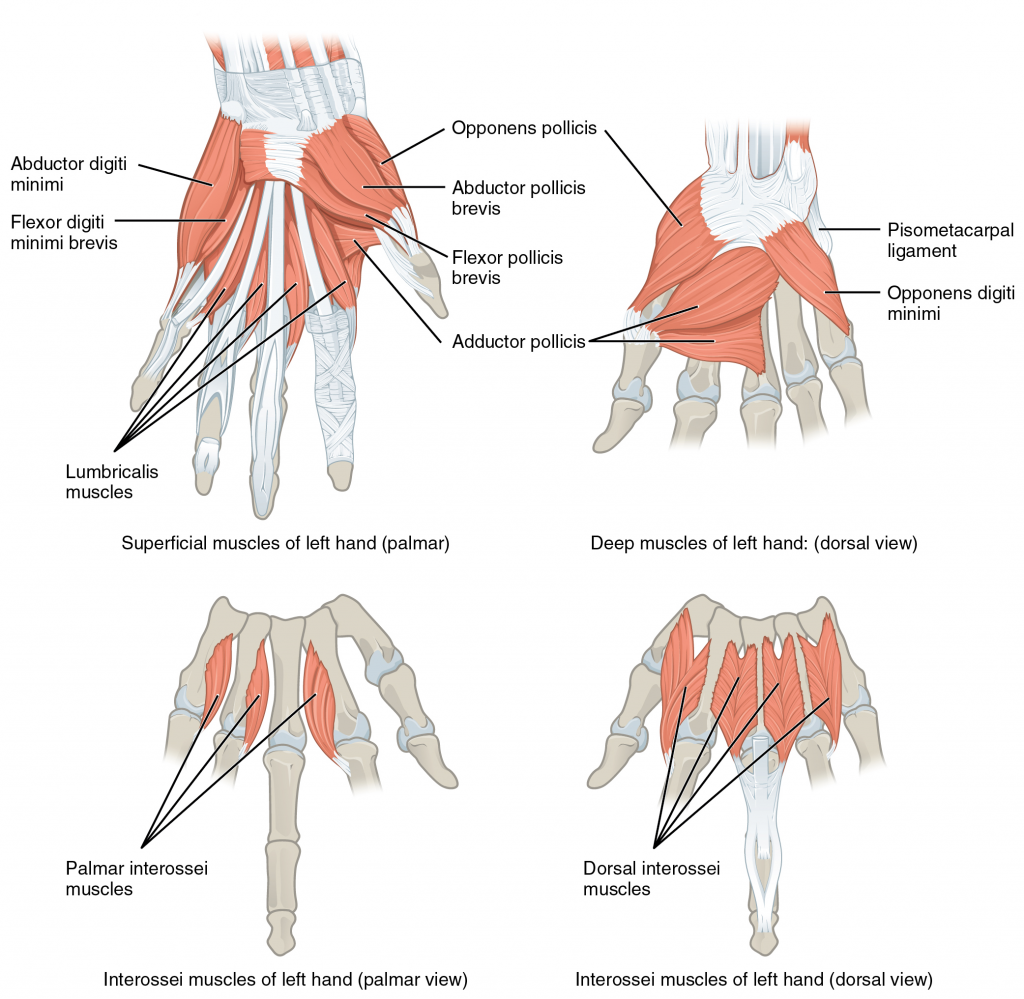
Anatomy
Upper Limb
Question 169 of 180
A 21 year old man presents to ED with multiple lacerations to his right upper limb, after falling through a ground floor window during a fight. He is unable to flex the distal interphalangeal joints of the fourth and fifth digits. Which of the following muscles is most likely affected:
Answer:
The ulnar nerve runs a superficial course and is vulnerable to laceration. The flexor digitorum profundus, innervated by the ulnar nerve medially and the median nerve laterally, acts to flex the distal interphalangeal joints and the metacarpophalangeal joints of the medial four fingers. The flexor digitorum superficialis, innervated by the deeper median nerve, acts to flex the proximal interphalangeal joints and the metacarpophalangeal joints of the medial four fingers. The flexor carpi ulnaris acts to flex and adduct the wrist. The interossei mainly act to adduct and abduct the fingers. The lumbricals act to flex the medial four fingers at the metacarpophalangeal joints and extend them at the interphalangeal joints.Hand Movements
Anatomy / Upper Limb / Wrist and Hand
Last Updated: 29th January 2019
Hand movements are complex. The table below shows an overview of hand and thumb movements and the main muscles bringing about these movements.
Table: Movements of the Finger Joints
| Finger Movements | Primary Muscle (Assisting Muscles) | Primary Nerve (s) |
|---|---|---|
| Flexion of MCPJ of digits 2 – 5 | Lumbricals (flexor digitorum superficialis, flexor digitorum profundus, flexor digiti minimi, interossei) | Median and ulnar |
| Flexion of PIPJ of digits 2 – 5 | Flexor digitorum superficialis (flexor digitorum profundus) | Median |
| Flexion of DIPJ of digits 2 – 5 | Flexor digitorum profundus | Median and ulnar |
| Extension of MCPJ of digits 2 – 5 | Extensor digitorum, extensor indicis, extensor digiti minimi | Radial |
| Extension of PIPJ and DIPJ of digits 2 – 5 | Lumbricals and interossei (extensor digitorum) | Ulnar and median |
| Adduction of digits 2 – 5 | Palmar interossei | Ulnar |
| Abduction of digits 2 – 4 | Dorsal interossei | Ulnar |
| Abduction of little finger | Abductor digiti minimi | Ulnar |
| Opposition of little finger | Opponens digiti minimi | Ulnar |
Table: Movement of the Thumb Joints
| Thumb Movements | Primary Muscle(s) | Nerve Supply |
|---|---|---|
| Flexion of thumb at MCPJ | Flexor pollicis longus and brevis | Median and ulnar |
| Flexion of thumb at IPJ | Flexor pollicis longus | Median |
| Extension of thumb at CMCJ and MCPJ | Extensor pollicis longus and brevis | Radial |
| Extension of thumb at IPJ | Extensor pollicis longus | Radial |
| Abduction of thumb | Abductor pollicis longus and brevis | Radial and median |
| Adduction of thumb | Adductor pollicis | Ulnar |
| Opposition of thumb | Opponens pollicis | Median |

Muscles of the Hand. (Image by OpenStax [CC BY 4.0 , via Wikimedia Commons)
Report A Problem
Is there something wrong with this question? Let us know and we’ll fix it as soon as possible.
Loading Form...
- Biochemistry
- Blood Gases
- Haematology
| Biochemistry | Normal Value |
|---|---|
| Sodium | 135 – 145 mmol/l |
| Potassium | 3.0 – 4.5 mmol/l |
| Urea | 2.5 – 7.5 mmol/l |
| Glucose | 3.5 – 5.0 mmol/l |
| Creatinine | 35 – 135 μmol/l |
| Alanine Aminotransferase (ALT) | 5 – 35 U/l |
| Gamma-glutamyl Transferase (GGT) | < 65 U/l |
| Alkaline Phosphatase (ALP) | 30 – 135 U/l |
| Aspartate Aminotransferase (AST) | < 40 U/l |
| Total Protein | 60 – 80 g/l |
| Albumin | 35 – 50 g/l |
| Globulin | 2.4 – 3.5 g/dl |
| Amylase | < 70 U/l |
| Total Bilirubin | 3 – 17 μmol/l |
| Calcium | 2.1 – 2.5 mmol/l |
| Chloride | 95 – 105 mmol/l |
| Phosphate | 0.8 – 1.4 mmol/l |
| Haematology | Normal Value |
|---|---|
| Haemoglobin | 11.5 – 16.6 g/dl |
| White Blood Cells | 4.0 – 11.0 x 109/l |
| Platelets | 150 – 450 x 109/l |
| MCV | 80 – 96 fl |
| MCHC | 32 – 36 g/dl |
| Neutrophils | 2.0 – 7.5 x 109/l |
| Lymphocytes | 1.5 – 4.0 x 109/l |
| Monocytes | 0.3 – 1.0 x 109/l |
| Eosinophils | 0.1 – 0.5 x 109/l |
| Basophils | < 0.2 x 109/l |
| Reticulocytes | < 2% |
| Haematocrit | 0.35 – 0.49 |
| Red Cell Distribution Width | 11 – 15% |
| Blood Gases | Normal Value |
|---|---|
| pH | 7.35 – 7.45 |
| pO2 | 11 – 14 kPa |
| pCO2 | 4.5 – 6.0 kPa |
| Base Excess | -2 – +2 mmol/l |
| Bicarbonate | 24 – 30 mmol/l |
| Lactate | < 2 mmol/l |

